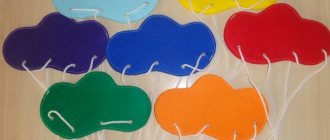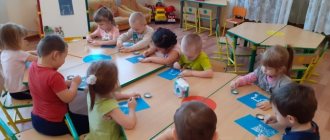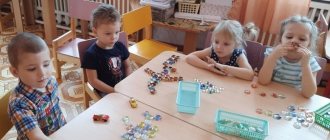- Course duration – 10 months (80 lessons)
- Frequency – 2 times a week
- Lesson duration – 50 minutes
- Children study with mothers
- The set includes 80 notes with illustrations and music files.
This course is aimed at the comprehensive development of a child aged 2 to 3 years.
We place our main emphasis on the intellectual direction - teaching reading and mathematics, developing speech, studying the world around us, developing attention, memory, logic, and thinking. However, the course also contains other elements - creative crafts, listening to classical music, dynamic pauses aimed at developing the child’s gross motor skills. View an example of a summary →
Topics of notes:
September
1. Meeting of friends 2. Learning to be friends 3. Hello, windy breeze 4. Breeze and rain 5. Orchard 6. Vitamin boost 7. Gifts from the village 8. What grows in the garden
October
9. Who lives on the farm 10. Domestic animals and their babies 11. The chicken is looking for its mother 12. The chicken and the duckling 13. Lost supplies 14. Forest animals 15. Trees 16. Trees. Miraculous transformations
November
17. Wild birds 18. Birds in the city 19. Matryoshka 20. Favorite toys 21. Box of pencils 22. Magic paints 23. Pyramid 24. Ball
December
25. Fun tea party 26. Dishes 27. What’s for lunch today 28. Edible and inedible 29. This is Africa! 30. Elephants and giraffes 31. Visit the penguins! 32. Polar bears
January
33. White in winter, gray in summer 34. Teddy bear 35. House 36. Everyone in the world needs a house 37. Long live scented soap 38. Good Doctor Aibolit 39. Big and small 40. Hot and cold
February
41. Round-square 42. Day and night 43. Clothing 44. Clothing 45. Shoes 46. Generalization. Shoes and clothes 47. Dad's helpers 48. Watches
March
49. Helping mom 50. Grandma visiting 51. Household appliances 52. Where the sparrow dined 53. Elephant’s birthday 54. Let’s go to the theater 55. Telephone 56. Rainbow
April
57. Sea trip 58. Fish 59. Furniture 60. Furniture 61. Shopping 62. I love my horse 63. Such different cars 64. Train
May
65. Air travel 66. Transport. Generalization 67. Flowers 68. Ladybug 69. Butterflies 70. Ant 71. Bee 72. Frog
June
73. Snail 74. Turtle 75. On a forest path 76. Dandelions 77. Water Sorceress 78. Kittens and gloves 79. Magician 80. Dunno visiting a baby
What should a child be able to do by the age of two?
Most often, the level of development of a 2-year-old child allows him to run quite quickly, climb stairs, and easily overcome low obstacles. Many children are particularly “climbing” in this period of life, and don’t feed them bread, let them climb somewhere higher.
From games, complex buildings made from cubes are perfectly mastered: towers, pyramids, structures that are strange for adults, reminiscent of fortresses. The pyramid should also be well studied. The child should be able to easily assemble it from the larger ring to the smaller one. Games with the ball become more mature: the child catches it with both hands, knows how to kick and throw it in the right direction.
Games take on a plot; this is especially easy to understand if you watch a child in a group. The baby prepares lunches in the sandbox, feeds toys, and may try to feed his peers. The baby should already be able to drink and eat on his own, without excessive waste of food from a spoon. It is better for the development of the child, by 1.5 or 2.5 in extreme cases, to seat him for lunch at a small children's table. This is a great start to preparing for kindergarten.
What else should a child be able to do:
- provide age-appropriate help around the house;
- be able to use not only a spoon, but also a fork;
- understand and respond to requests, stories, questions, suggestions;
- ask questions when parents read books or show cartoons;
- know most body parts of yourself, others, animals;
- know at least 100 words and pronounce them; Slightly poor pronunciation is acceptable at this age;
- make short sentences;
- use the pot for needs;
- be able to study with cards, books, pronounce words after adults;
- know animal sounds;
- try to draw, distinguish between several colors;
- knows what “impossible” and “dangerous” are.
Tip: Your baby is active. To prevent flat feet, it is recommended to purchase special massage mats and place them in the place where the baby runs most often during the day. For example, in the corridor. If you are passionate about handicrafts, such a rug is easy to make yourself: buttons, beads, pieces of fabric of various densities, and caps from felt-tip pens are sewn onto thick fabric. These rugs are recommended for use from 1.5 years.
What do you get when you purchase this set of notes?
- You receive 80 notes for classes with children from 2 to 3 years old for 10 school months, 2 times a week,
- Illustrations for all notes:
- Colorful pictures for the block “The world around us” for printing or displaying on the screen through a projector
- Black and white worksheets for the unit "Preparing the hand to write" (children take home)
- Creative block illustrations when needed
- Files with musical or sound accompaniment (for example, the sound of water, the roar of an animal, the chimes, a folk song), when this does not violate anyone's copyright. In other cases, we give instructions on how you can purchase a disc with this melody.
And bonuses:
Bonus #1 . A list of everything you will need for classes - toys, teaching aids, stationery and much more.
Bonus #2 .
Scenarios for three holidays for children of this age. The scripts have been worked out and contain recommendations for the design of premises, descriptions of props, costumes and scenery, and musical accompaniment.
Sensory development
For sensory development in children 2-3 years old, sensory boxes are ideal for use. To make such a simulator, you need to allocate a large container that can be filled with colored cereals, orbiz (this is a hydrogel that is not expensive, but its benefits are enormous), and sand. Stores offer an abundance of various fillers for sensory boxes: orbiz can be bought at a flower shop, ordered from China, or looked for in children's stores. You can buy kinetic sand or “smart” modeling clay. Give your child such a box, a couple of small molds, spatulas and a rake, bury new small toys in the filling and the child will be busy for a good 20-40 minutes.
Games for the sensory development of a 2-year-old child - space for the imagination of moms and dads. Be sure to let your baby participate in cooking. Show the potato in the skin, let him touch it, then peel it and give it to the child again. Then cut - again let's feel the pieces. Such a simple, everyday thing, but its effectiveness is amazing.
Also an excellent training tool would be a bag where you can put toys of different shapes and sizes and ask the child to take out first the large one, then the medium one, the rough one, the soft one, and so on. Modern special books for children can become a wonderful simulator for developing tactile sensations. In such books, for example, a tiger is shown on the page, and there is an insert with artificial tiger fur. You can touch it and study it. Such books cause wild delight in children.
Reviews
According to our notes, hundreds of children's centers in Russia and the CIS countries are already operating. They received the approval of not only practical teachers, leaders of children's clubs, but also very respected representatives of the scientific community.
Podvoisky V.P., professor, Doctor of Pedagogical Sciences, Candidate of Psychological Sciences, member of the educational and methodological council for early childhood development, professor of the Department of Psychology at Moscow Pedagogical State University:
“The considered methodology of Yu. Belotserkovskaya and Z. Ivanter represents interesting material, which is sufficiently updated in the light of reforming the modern system of preschool education...”
“The components of the classes (greeting, warming up, reading, logorhythmics, mathematics, studying the properties of objects, general motor, finger gymnastics, artistic and creative activities / applique, drawing, modeling /, farewell) not only correspond to the natural course of dramaturgy, but also allow you to engage emotionally -sensory, visual-motor, tactile-auditory perception of children..."
“In such psychological and pedagogical conditions, the time frame of attention expands, and memory begins to intensify its work...”
“The applications used in the methodology are not just a colorful addition, but are organically woven into the content of the plot and semantic lines. They allow you to make the necessary accents, switch attention and continue to “swim children on the wave of new knowledge”...
“The analyzed methodology should be published in a good edition so that it becomes fully accessible to Early Childhood Development Centers.”
Blokh O.A., Doctor of Pedagogical Sciences, Professor of the Department of Pedagogy and Psychology, member of the Union of Writers of the Russian Federation, General Director of Children's, Vice-President of the International Academy of Informatization at the United Nations (department of music, education):
“The methodology […] arouses interest and deserves attention at the structural, content and technological levels. The methodology includes lesson notes, checklists (list of materials used, props, developmental elements), various musical, visual and artistic applications. The structure of the lesson represents a holistic system construction and accumulates such important components as greeting, warm-up, reading, logarithmics, mathematics, studying the properties of objects, general motor, finger gymnastics, artistic and creative activities (appliqué, drawing, modeling, etc.), farewell ( the final). Each section of classes has its own target setting...”
“It should be noted as a positive aspect the creation of a creative environment in the classroom through the active participation of children, parents and teachers in the developmental process based on the development of a culture of communication and a culture of behavior. In this method, the processes of training and education are naturally intertwined and form a harmonious whole...”
“It is important to pay attention to the fact that all the material in the methodology fully complies with the principles of health-preserving pedagogy and meets the multifaceted specifics of the early holistic development of children...”
“The methodology can be published in a scientific and methodological publication and serve as the basis not only for practical activities, but also for scientific and creative research...”
View original reviews in full for all courses
Physical development
For the physical correct development of a child at 2 years old, there are hundreds of recommendations, disputes about which will never subside. We recommend, first of all, that you closely monitor your child:
- If your baby runs, jumps a lot, and loves outdoor games, your only task is to provide him with the conditions for this. Walk more, come up with fun games, do morning exercises in the morning.
- If the baby is a leisurely child who prefers calmer games, then you can choose games that will simultaneously train him and not push him away with excessive activity. On the street you can collect pine cones or flowers in a basket, walk back and forth along the curb, or play tag.
Advice: In 100 cases out of 100, the child is infected by the parents’ lifestyle. If you prefer to spend extra time sitting at the computer or with a phone in your hand, rest assured that your child will love what you love. If mom and dad do exercises, jogging and don’t have bad habits, this will also become a standard of life behavior for the baby. The bad parent is the one who demands from the child what he himself does not do.
Cost of a set of notes
| 1 month | 8 fully written notes + Illustrations for notes + Sound files (the sound of rain, animal voices, chimes, folk songs, etc.) | 4000 rub. |
| 5 months | 40 fully written notes + Illustrations for notes + Sound files (the sound of rain, animal voices, chimes, folk songs, etc.) | 16,000 rub. |
| 10 months | 80 fully written notes + Illustrations for notes + Sound files (the sound of rain, animal voices, chimes, folk songs, etc.) + Bonus No. 1. List of all toys, teaching aids and stationery that will be required for classes + Bonus No. 2. Scenarios for three holidays | 30,000 rub. |
If you have ever been interested in the question of building an educational process in a children's center, you immediately realized how attractive this offer is. When purchasing a complete set of notes, one month costs 3,000 rubles. In Moscow, this is the cost of one monthly subscription. That is, one new client will already recoup your investment in notes. (Outside Moscow, this is the cost of three or four subscriptions. This means that your investment will return three or four new clients).
At the same time, the presence of this curriculum in the club will attract not just a few, but dozens of new students.
Fine motor skills
For the development of fine motor skills in children 2 years old, large buttons, colored pasta, and sensory boxes, which we already discussed a little higher, are suitable. Give your child a string and a handful of colored pasta and show him how to make fancy beads if you have a girl and a bunch of gun cartridges if you have a boy.
Massage is perfect for finger development. Gently massage each finger in turn and play magpie-crow. Try to teach your child to fasten his own buttons as soon as possible. Speech therapists advise giving your child buckwheat mixed with rice or peas. It is not necessary for the child to do this for 20 minutes. 5-7 minutes is enough.
Games that develop fine motor skills:
- modeling with plasticine, clay, salt dough;
- It is useful to stick plasticine or paste onto stencils and drawings;
- appliques, working with scissors - an excellent simulator;
- games with clothespins, clamps;
- games with cereals, busy boards;
- putting together puzzles, sorting out magnets of different shapes on the refrigerator;
- The new magnetic construction set performed well.
Tip: How to color cereals or pasta? Dissolve food coloring in 3-6 ml of water in a container. Add cereal or pasta. Gently shake and scatter on a table covered with cling film or a bag to dry for 10 hours.
The more independent a child is, the less likely it is that a child will be developmentally delayed at 2 years of age. Allow him to do everything that is not dangerous to his health and well-being. If a baby climbs a hill, it is better to insure than to prohibit it. If he wants to help clean up, give him a broom or vacuum cleaner. If your hands reach for the food cupboard, pour a couple of handfuls of cereal into the container and tell them how to cook the porridge. Everything is important for finger motor skills: every movement trains the fingers in one way or another, develops muscles and tenacity.
How quickly will you receive your notes?
Very fast. Previously, we sent material on disk, but due to disruptions in the work of postal operators, we abandoned this practice and introduced the transfer of information through a personal account.
How does this happen? We will send you a login and password so that you can log into your personal account and save all materials on your computer. The information is not stored on a disk, which can be scratched, broken or lost, but on your computer. You will receive your order quickly and in an easy-to-use form.
So if you want:
- Have a consistently high quality of classes, ensured by documented processes
- Save on teachers' salaries by attracting young specialists
- Do not depend on the whims of star teachers
- Minimize the risk of losing clients due to teachers leaving
- Conduct classes according to a program that has already been worked out by other successful children's centers and highly qualified teachers
- Work in the most productive mode, without being distracted by buying study guides and drawing handouts
- Attract more clients by explaining to parents that the club has its own methods of child development, telling in detail about the classes provided
- Spend holidays with children according to detailed and worked out scenarios, including descriptions of props,
then this kit may come in handy.
Features of this age
Surely every mother or father has already noticed that the child’s coordination has improved significantly, the baby very rarely falls “out of the blue,” and games have become much more meaningful. It's time to introduce the baby to toys - sorters, a large construction set, a pyramid. Large magnetic puzzles and wooden games for learning shapes and colors are perfect for developing motor skills in children aged 1-2 years.
A feature of the development of a 2-year-old child is the improvement of logical thinking. The baby is actively exploring the world, he is interested in finding solutions to various problems on his own, and his favorite pastime is helping his family with household chores. It is important to support the baby in this endeavor, allow him to help with vacuuming, washing dishes, and choosing his own clothes according to the weather. Even if such help resembles pampering, in the future you won’t have to force the baby to collect toys and things.
Surely the first toys have already been broken and disassembled - the child is interested in the question “how does it work.” The technique arouses great curiosity; it is recommended to tell the child as much as possible, show simplified diagrams and cards.
Football is great for physical development. Kicking a ball with your daughter or son in the yard is an excellent training for your sense of space, physical endurance, accuracy, and coordination. Let such development of a child at just 2 years old seem unnecessary or strange to you, but research shows that already at this age, it is versatile activities that are useful. Today we kick a ball, tomorrow there will be modeling, the day after tomorrow we learn to draw, the next day we glue the first appliqués.
Advice: Your calm, diligent baby is about to become a bully and begin to say “no” to everything. The three-year crisis is approaching. Daily varied activities will help both you and your baby get through this difficult time much more smoothly.




